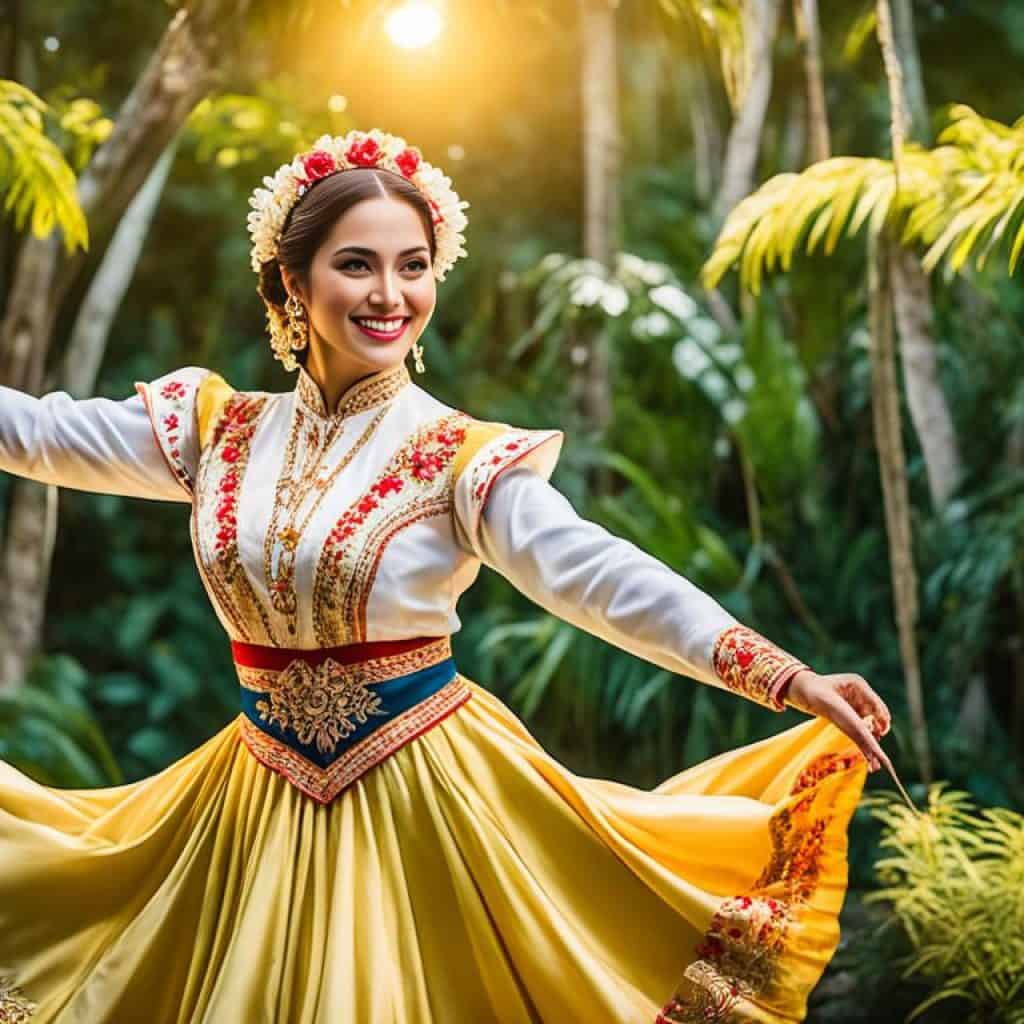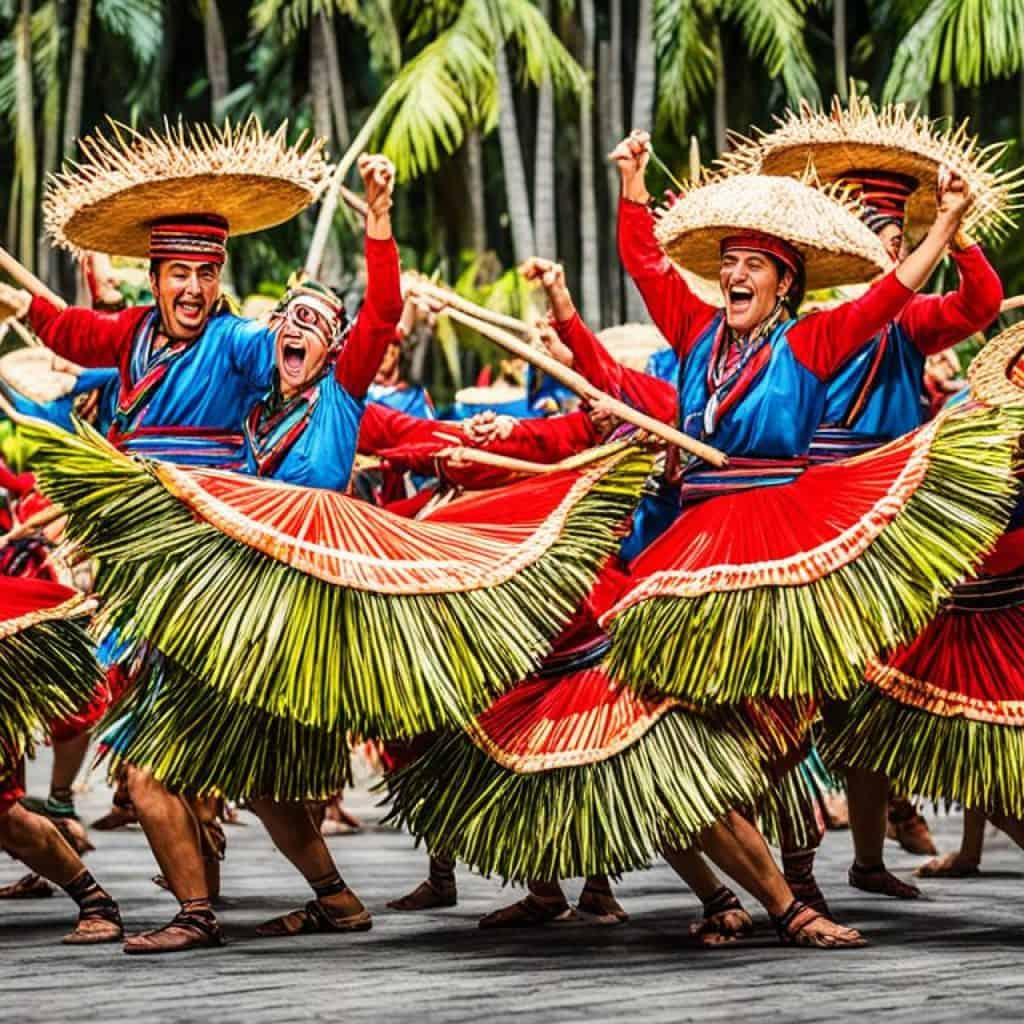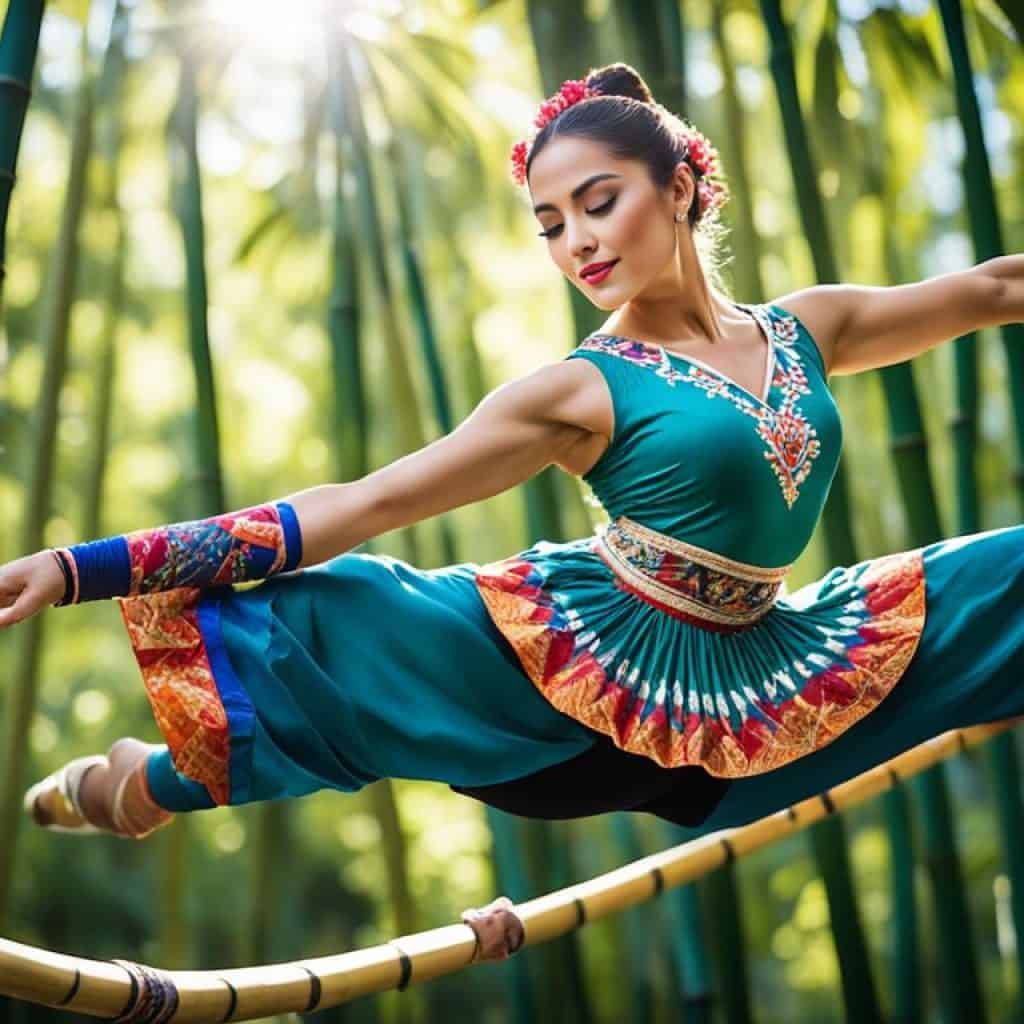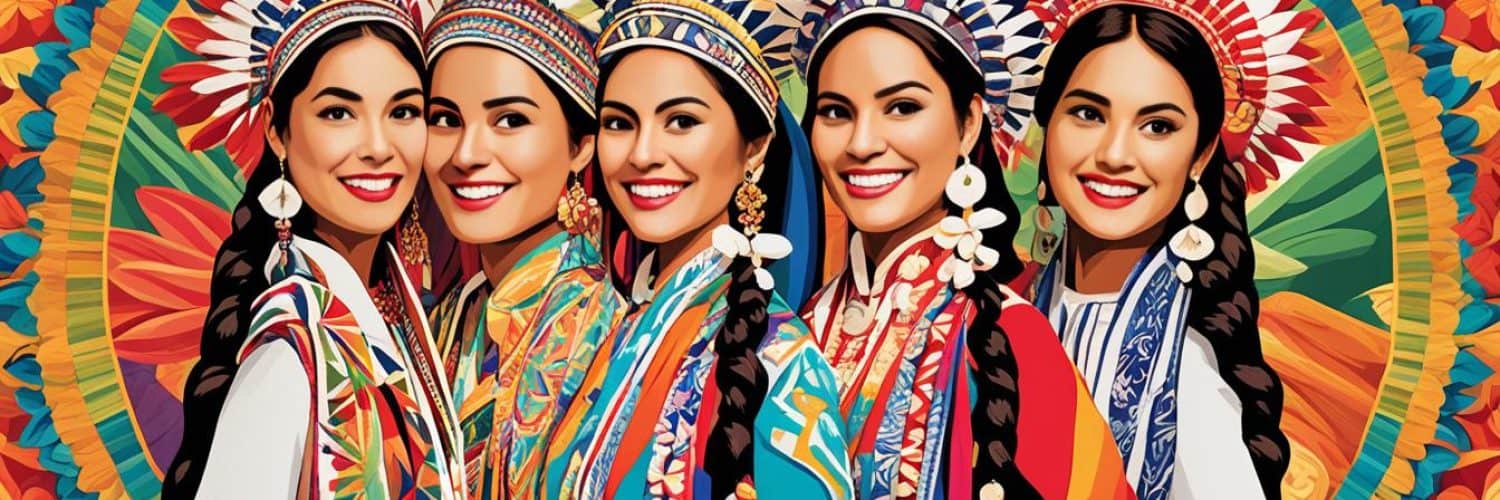Have you ever wondered about the captivating and diverse folk dances of the Philippines? From graceful courtship dances to energetic battle reenactments, these dances embody the unique cultural heritage of the Filipino people. Join us as we delve into a fascinating list of Philippine folk dances that will transport you to a world of captivating stories, vibrant music, and rich traditions.
Key Takeaways:
- Philippine folk dances are an integral part of the country’s cultural heritage.
- Each dance tells a unique story and showcases the beauty of the Philippines’ diverse culture.
- These dances symbolize various aspects of Philippine life, including love, courtship, and history.
- Preserving and celebrating these folk dances is essential to keep the traditions alive.
- Join us on a journey through the enchanting world of Philippine folk dances and discover the rich tapestry of Filipino culture.
Tinikling – The National Dance of the Philippines
Tinikling holds a special place as the most well-known and beloved folk dance in the Philippines. Reflecting the grace and agility of tikling birds, whose name it bears, the dance has become an iconic symbol of Philippine culture.
The inspiration behind Tinikling lies in the movements of tikling birds as they elegantly hop between bamboo poles. Intricately choreographed, the dance requires two clickers to sit on the ground and rhythmically tap the bamboo poles, while two dancers gracefully and skillfully move between them, avoiding getting caught in between.
With quick and nimble footwork, the dancers showcase their dexterity and synchronization, creating a mesmerizing spectacle of artistry and rhythm. Tinikling has captivated audiences worldwide with its vibrant energy and engaging performance, making it a cherished representation of Philippine heritage.
Notably, Tinikling has been officially recognized as the National Dance of the Philippines, standing as a testament to its significance and cultural value. It serves as a constant reminder of the country’s rich traditions and celebrates the spirit of unity and harmony.
This image showcases the beauty and grace of Tinikling, as dancers expertly maneuver between the bamboo poles, emulating the agile movements of tikling birds.
Cariñosa – A Dance of Love and Courtship
Another popular folk dance in the Philippines is Cariñosa, which represents the graceful movements and courtship rituals of Filipina women during the Spanish Colonial Period. It is performed by a male and female dancer, with the male trying to win the affection of the female through flirtatious movements using a fan and a handkerchief. Cariñosa is part of the Maria Clara Suite, a collection of dances that depict love and courtship during the Spanish colonial era.
The Cariñosa dance is a celebration of elegance and charm. It showcases the intricate footwork, graceful hand movements, and subtle glides that capture the essence of courtship. The dancers move in sync, intertwining their steps with the rhythm of the music, creating a mesmerizing display of affection and attraction.
In the words of a renowned Filipino choreographer, “Cariñosa is not just a dance; it is a reflection of the rich cultural heritage and values of the Filipino people. It is a dance that evokes emotions, beauty, and the essence of courtship.”
During the dance, the male dancer approaches the female dancer with reverence and respect, expressing his admiration through gentle gestures and alluring fan movements. The female dancer, in turn, reciprocates by coyly responding to his advances, allowing the dance to unfold as a captivating interplay of emotions.
The Cariñosa dance is often performed on special occasions, such as weddings, festivals, and cultural events, showcasing the timeless traditions of courtship and romance in the Philippines. It serves as a reminder of the grace and poise of Filipina women and the importance of preserving and celebrating their cultural heritage.
Benefits of Cariñosa Dance
The Cariñosa dance not only preserves shared cultural history, but it also offers various benefits to those who practice it. Here are some of the advantages of engaging in this beautiful dance:
- Physical Fitness: Cariñosa requires precise footwork, fluid movements, and coordination, providing a great workout for the body.
- Emotional Expression: The dance allows individuals to express their emotions, love, and courtship in a creative and artistic manner.
- Improved Posture and Balance: Cariñosa promotes proper posture and balance, enhancing physical grace and poise.
- Connection to Heritage: By learning and performing Cariñosa, individuals can connect to their Filipino heritage and cultural roots.
- Stress Relief: Engaging in dance can offer a release from daily stressors, promoting relaxation and overall well-being.
Experience the Beauty of Cariñosa
Witnessing the Cariñosa dance is an enchanting experience that leaves a lasting impression. The combination of graceful movements, delicate costumes, and the rhythmic beats of traditional Filipino music creates an atmosphere of romance, charm, and cultural pride.
Immerse yourself in the elegance, grace, and courtship of the Cariñosa dance, and let the beauty of Philippine culture captivate your heart.
Pandanggo sa Ilaw – Balancing Oil Lamps with Grace
The mesmerizing dance of Pandanggo sa Ilaw originated from Lubang Island and is a prime example of a Philippine cultural dance. This captivating performance showcases the elegance and skill of Filipino dancers as they balance oil lamps or glasses with candles on their heads and in their hands. The dancers move with grace and fluidity, their every step a testament to the rich heritage of the Philippines.

The rhythmic clacking of castanets serves as the melodic accompaniment to Pandanggo sa Ilaw. These small percussion instruments are held and clicked together by the dancers in perfect synchronization with their movements. This adds an enchanting musical element to the dance, enhancing the overall beauty and allure of the performance.
Pandanggo sa Ilaw is typically performed in 3/4 time, creating a sense of elegance and rhythm. The dancers’ precise footwork, graceful poses, and intricate formations captivate the audience and transport them to a world where the oil lamps seem to dance alongside the performers.
This cultural dance is not only a visual spectacle but also a way of preserving and celebrating the Philippine traditions. Pandanggo sa Ilaw serves as a reminder of the rich cultural heritage and artistic talents of the Filipino people, showcasing their creativity, precision, and dedication to their cultural roots.
References:
“Pandanggo sa Ilaw.” Philippine Folk Dance. Accessed November 22, 2021. [Link to official Philippine Folk Dance website]
| Key Elements | Description |
|---|---|
| Origin | Lubang Island, Philippines |
| Featured Props | Oil lamps or glasses with candles, castanets |
| Musical Accompaniment | Castanets and traditional Philippine music |
| Time Signature | 3/4 time |
| Characteristics | Graceful and fluid movements, precise footwork, intricate formations |
Sayaw sa Bangko – Dancing on Benchtops
Sayaw sa Bangko is a captivating indigenous Filipino dance that originates from the Visayan region. This traditional dance showcases the strength, agility, and precision of the Filipino people in a unique and exciting way. Dancers perform intricate routines while balancing and maneuvering on top of narrow wooden benches. The skill and coordination required to execute the dance moves while maintaining perfect footing on the benches is truly impressive.
Sayaw sa Bangko is a visual spectacle that mesmerizes audiences with its combination of graceful movements and daring acrobatics. The dance highlights the talent and artistry of the performers as they navigate the challenging dance floor, weaving together intricate steps and patterns. It is a testament to the rich indigenous dance traditions of the Philippines and serves as a celebration of the country’s cultural heritage.
The Sayaw sa Bangko dance is often performed during special occasions, festivals, and cultural events. It is a powerful representation of Filipino identity, showcasing the resilience and adaptability of the Filipino people throughout history. Through this dynamic dance form, the beauty of the Visayan culture is brought to life, captivating audiences and fostering a deeper appreciation for the rich tapestry of traditions that make up the Philippines.
Key Elements of Sayaw sa Bangko
| Key Elements | Description |
|---|---|
| Wooden Benches | Narrow wooden benches serving as the dance floor |
| Intricate Routines | Complex dance moves that require agility and balance |
| Coordination | Precision and synchrony between dancers |
| Traditional Music | Live or recorded music accompanying the dance |
| Traditional Costumes | Colorful and vibrant outfits that reflect the Visayan culture |
Experience the awe-inspiring Sayaw sa Bangko and witness the extraordinary talent and dedication of the Filipino dancers. This indigenous Visayan dance is a true testament to the richness and diversity of the Philippine culture.
Kuratsa – A Dance of Courtship
Kuratsa is a popular dance performed at weddings in the Philippines. It is a vibrant and energetic dance that mimics the mating movements of a rooster and a hen. The dance consists of three parts, with the male dancer pursuing the female dancer in a chase before finally winning her over with his dance. Kuratsa is a beautiful expression of love and courtship in Philippine culture.
The Kuratsa dance is characterized by its lively and rhythmic movements, attracting the attention of the audience. It is a traditional folk dance that portrays the playful courtship between a man and a woman. The dancers showcase their agility, grace, and skill as they gracefully move across the dance floor, mesmerizing spectators with their enchanting performance.
This romantic Philippine dance is accompanied by traditional music that sets the mood for courtship and love. The melody of the music, combined with the movements of the dancers, creates a captivating atmosphere filled with emotions and excitement.
“Kuratsa is a dance that embodies the joy and beauty of courtship. It celebrates the art of pursuing love and the thrill of winning someone’s heart through the power of dance.”
During Kuratsa, the male dancer leads the courtship, displaying his strength, agility, and determination as he tries to woo the female dancer. The dance involves intricate footwork, lively steps, and elegant hand gestures, symbolizing the playful dance between a rooster and a hen in the wild.
Kuratsa is not only performed at weddings but also during other festive occasions and cultural events in the Philippines. It is a cherished dance that continues to be passed down through generations, preserving the traditions and values of Filipino courtship and romance.
Maglalatik – A Mock Battle Dance
Maglalatik is a captivating folk dance that showcases a unique blend of rhythm, movement, and tradition. Originating from Biñan, Laguna, this dance is a symbolic reenactment of a mock battle between the Christians and the Muslim Moro tribespeople. What makes Maglalatik truly distinct is the use of coconut shells as both armor and musical instruments.

The male dancers wear coconut shell halves on their bodies and skillfully hit them with coconut halves held in their hands, creating an infectious beat that reverberates through the performance. It is a visual and auditory spectacle that immerses the audience in the energy and rhythm of the dance.
Maglalatik is typically performed during religious processions and festivals, where the dancers move with precision and agility, engaging in a captivating display of strength and endurance. The dance is divided into four parts, with two dedicated to the battle and the other two to reconciliation, embodying the cycle of conflict and unity.
Through Maglalatik, the rich history and cultural heritage of the Philippines come to life, captivating audiences with its rhythmic intensity and powerful storytelling. This enthralling dance is a testament to the resilience and spirit of the Filipino people, as well as their commitment to preserving their traditions and celebrating their diverse cultural expressions.
Itik-Itik – Mimicking the Movements of Ducks
Itik-Itik, a lively Visayan dance, captivates audiences with its playful mimicry of duck movements. This delightful dance originated from a dancer named Kanang, who spontaneously created a routine inspired by a duck’s graceful motions during a baptismal celebration. Itik-Itik performers skillfully execute short, choppy steps while gracefully swaying their hands and wading, reminiscent of ducks gliding across water.
With its joyful and vibrant energy, Itik-Itik is a testament to the creativity and liveliness of the Filipino people. Through this dance, they express their fondness for nature and their playful spirit, captivating audiences with their graceful and amusing duck-like movements.
“The Itik-Itik dance truly showcases the Filipino people’s creativity and playfulness. It is a delightful performance that never fails to bring joy and laughter to the audience.”
Binasuan – Balancing Drinking Glasses with Precision
Binasuan is a captivating Philippine folk dance originating from the province of Pangasinan. It is a Pangasinan traditional dance that showcases the impressive skill and precision of the dancers as they balance drinking glasses filled with rice wine on their heads and hands. This unique dance requires meticulous control and coordination, making it a true spectacle to behold.
The dancers of Binasuan gracefully move and perform intricate steps while keeping the glasses perfectly balanced. The wine inside the glasses adds an additional challenge, as any sudden movement can cause spillage. However, the dancers exhibit exceptional dexterity and poise, never wavering in their focus to create a flawless performance.
Binasuan is often performed during special occasions such as weddings and festivals, where it adds an air of elegance and celebration. The combination of the dancers’ graceful movements and the delicate balance of the wine-filled glasses creates a visually stunning display that captivates audiences.
“Binasuan represents the rich cultural heritage of the Pangasinan people. It is a magnificent display of talent, precision, and the embodiment of celebration.” – Local Dance Historian
Through Binasuan, the dancers pay homage to their cultural roots and the traditions passed down from generation to generation. This mesmerizing performance reminds us of the beauty and artistry found in Philippine folk dances, preserving the rich tapestry of the country’s diverse heritage.
Binasuan Dance Steps:
- The dancers begin by gracefully entering the performance area, their bodies adorned in colorful traditional attire.
- They carefully balance two drinking glasses filled with rice wine on the palms of their hands.
- With precision and coordination, the dancers move in sync, stepping gracefully to the rhythm of the music.
- They execute intricate footwork, maintaining their balance and ensuring the glasses remain steady.
- The dancers smoothly transition into spins and turns, showcasing their agility and grace.
- Throughout the performance, the dancers maintain their poised posture while keeping the glasses perfectly balanced.
- The dance culminates in a breathtaking finale, with the dancers executing a final pose, showcasing their skill and mastery of Binasuan.
Experience the breathtaking beauty of Binasuan as it combines precision, skill, and cultural heritage. This Philippine traditional dance transports audiences to the province of Pangasinan, embracing the grace and elegance of the Filipino people.
Discover the extraordinary artistry of Binasuan and immerse yourself in the rich tapestry of Philippine folk dances.
Singkil – A Dance of Epic Legend
Singkil is a captivating Maranao dance that brings to life the epic legend of Princess Gandingan as she traverses a forest of swaying trees amidst a powerful earthquake. With each graceful movement, the dancers skillfully navigate their way through the crossing bamboo poles, symbolizing the falling trees. Accompanied by the rhythmic beating of bamboo poles, Singkil embodies the resilience and artistry of the Maranao people, preserving their cultural heritage and captivating mythology.
This exquisite Maranao dance is a testament to the rich storytelling tradition of the Philippines. It reflects the courage and determination of Princess Gandingan and serves as a reminder of the strength and resilience of the human spirit in the face of adversity. Singkil carries the audience on a journey through the epic legend, captivating them with its intricate choreography and mesmerizing music.
“Singkil transports us to a world of enchantment and wonder, where legends come to life through the graceful movements of the dancers. It is a celebration of both cultural heritage and the human spirit.”
Shrouded in history and mythology, Singkil is more than just a dance; it is an embodiment of the Maranao people’s identity and a testament to their rich artistic traditions. The dance serves as a medium through which stories are told, preserving the cultural heritage and captivating the imaginations of both locals and visitors. Singkil is a true masterpiece that showcases the intricate beauty and artistry of Philippine epic dance.
Unique Elements of Singkil:
- Intricate choreography depicting the epic legend of Princess Gandingan
- Graceful navigation through crossing bamboo poles
- Rhythmic beating of bamboo poles accompanying the dance
- Symbolic representation of resilience and strength in the face of adversity
Through Singkil, viewers are transported into a world of wonder and imagination, where the fusion of dance, music, and storytelling creates an unforgettable experience. This Maranao dance is a testament to the artistic prowess of the Filipino people, showcasing their rich cultural heritage and captivating the hearts of all who witness its enchanting performance.

La Jota Moncadeña – Spanish-Influenced Dance of Celebration
La Jota Moncadeña is a captivating Filipino dance that originated as an adaptation of the traditional Spanish Jota dance. This remarkable cultural fusion combines Spanish and Ilocano dance steps, resulting in a vibrant and lively performance that embodies the spirit of celebration. La Jota Moncadeña captivates audiences with its energetic movements and infectious rhythms, making it a beloved part of the Philippines’ rich dance heritage.
During La Jota Moncadeña, dancers showcase their agility and grace as they move to the rhythmic beat of castanets, creating a festive ambiance. The dance blends traditional Spanish music with native Filipino elements, infusing it with a distinct charm. The performers’ intricate footwork, partnered with the vibrant costumes and lively atmosphere, transport spectators to a joyous celebration filled with cultural pride.
La Jota Moncadeña holds a special place in the hearts of Filipinos, as it represents the cultural influence of Spanish colonization in the Philippines. It serves as a testament to the resilience and adaptability of the Filipino people, embracing their historical connections while infusing the dance with their own unique flair.
Whether performed at weddings, festivals, or other special occasions, La Jota Moncadeña never fails to captivate and uplift audiences. Its combination of Spanish and Ilocano dance steps, complemented by the rhythm of castanets, creates a truly immersive experience that showcases the beauty and diversity of Philippine culture.
Experience the infectious energy and cultural richness of La Jota Moncadeña through this captivating performance:
| Key Features | Details |
|---|---|
| Dance Origin | Philippines (adaptation of Spanish Jota dance) |
| Influences | Spanish and Ilocano dance styles |
| Accompaniment | Castanets and traditional Spanish music |
| Social Context | Performed at special celebrations and cultural events |
| Meaning | A representation of the cultural influence of Spanish colonization in the Philippines |
Pantomina – The Doves’ Courtship Dance
In the enchanting region of Bicol in the Philippines, there is a traditional courtship dance known as Pantomina. This captivating dance is performed by newlyweds during wedding feasts, symbolizing the start of their journey as a married couple. Pantomina derives its name from the Spanish word “pantomime,” as it mimics the graceful movements of doves during their courtship rituals.
In Pantomina, the dancers, adorned in traditional attire, move with elegance and fluidity, capturing the essence of doves as they flutter their wings and gracefully maneuver through the air. The dance showcases the harmony and synchronicity between the couple, symbolizing the deep bond of love and unity.
The rhythmic music accompanying Pantomina sets the tone for the dance, creating an atmosphere of joy and celebration. Wedding guests often participate by throwing coins or placing cash on a plate as the couple performs, symbolizing their wishes for prosperity and blessings in the newlyweds’ life together.
Experience the beauty and grace of Pantomina, a cherished highlight of Philippines wedding celebrations and a testament to the rich cultural heritage of the Bicolano people.
Discover the elegance of Pantomina in this captivating image:
| Key Features | Symbolism |
|---|---|
| Graceful and flowing movements | Mimics the courtship rituals of doves |
| Performed by newlyweds | Symbolizes the start of their married life |
| Accompanied by lively music | Captures the festive spirit of weddings |
| Guests throw coins or place cash | Wishes for prosperity and blessings |
Conclusion
Philippine folk dances are an integral part of the country’s cultural heritage, representing the vibrancy, diversity, and richness of its traditions. These dances serve as a window into various aspects of Philippine life, showcasing the beauty of love, courtship, nature, and history.
Preserving and celebrating these folk dances is crucial in order to keep the traditions alive and pass them on to future generations. By embracing and showcasing these dances, the Philippines proudly exhibits its unique cultural heritage to the world.
From the graceful movements of Tinikling to the lively and joyful Itik-Itik, each dance carries its own distinctive story and connects generations of Filipinos to their roots. These dances not only entertain but also serve as a powerful reminder of the enduring values, customs, and artistry that define the Philippine people.
As we continue to honor and appreciate these folk dances, we are not only preserving our cultural identity but also contributing to the global tapestry of traditions. Let us embrace and celebrate the folk dances of the Philippines, ensuring that they continue to inspire, captivate, and educate generations to come.


















Add comment